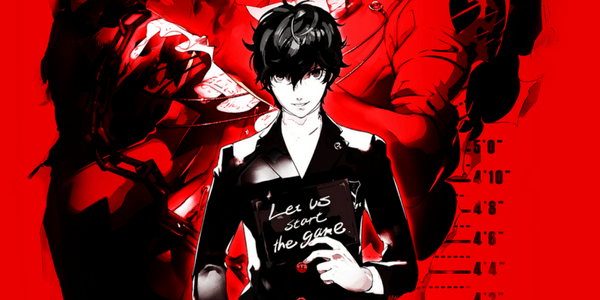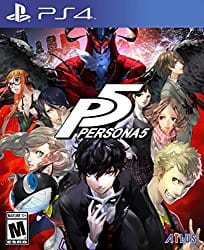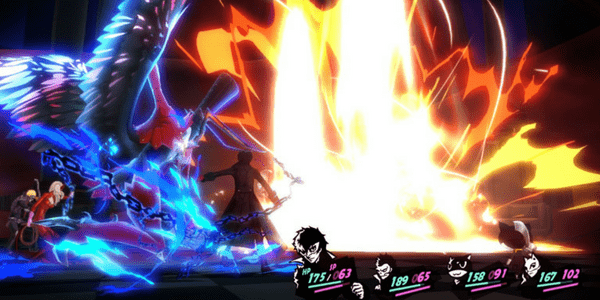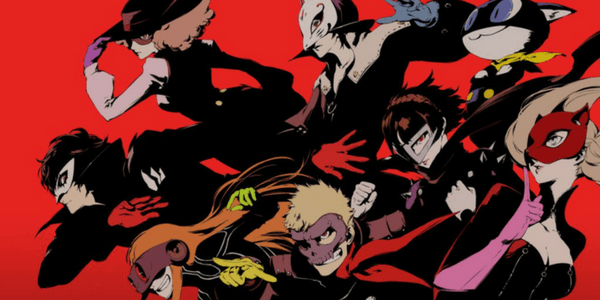
Note: This article contains some spoilers, but none for the end of the game.
The entire Persona series draws heavily from Jungian psychology and the western magical tradition, but Persona 5 demonstrates a practical side to these things in what is, strangely, one of the most accurate portrayals of magical living I’ve ever seen.
The plot eventually escalates into government conspiracies and conflict between cosmic forces of order and chaos, but the game remains largely grounded in day-to-day life and the protagonist’s struggle to balance mundane concerns with his hectic magical double-life. And with its themes of standing up against injustice, it’s topical.
The set up
 Persona 5 begins with the teenage protagonist, later nicknamed Joker, on probation after he was convicted of assault for defending a woman from an attacker. After transferring to a new high school, he tries to keep his head down and be an ordinary student, but he begins having recurring dreams of being in an otherworldly prison. The warden speaks in vague terms about “rehabilitation” and “the game” and offers him freedom if he should win.
Persona 5 begins with the teenage protagonist, later nicknamed Joker, on probation after he was convicted of assault for defending a woman from an attacker. After transferring to a new high school, he tries to keep his head down and be an ordinary student, but he begins having recurring dreams of being in an otherworldly prison. The warden speaks in vague terms about “rehabilitation” and “the game” and offers him freedom if he should win.
Joker discovers a mysterious navigation app on his phone that transports him to a surreal castle, which turns out to be a subconscious distortion originating from one of his new teachers. During a dramatic confrontation with his teacher’s Shadow Self, he gains the ability to summon psychic avatars called “personas” that allows him to explore and ultimately alter the subconscious minds of others. ((MELOO, “Persona 5: Protagonist Awakening (English DUB),” YouTube, 31 March 2017.))
Joker begins gathering a group of like-minded outcasts who, through their own struggles, develop these same powers. Determined to help others like themselves, they style themselves the “Phantom Thieves of Hearts” and begin to use their new abilities to force corrupt and abusive people to confess their crimes and make amends.
The Metaverse
The strange world Joker stumbled into turned out to be the Metaverse, a non-physical realm made of humanity’s ideas, symbols, and emotions, very similar to Carl Gustav Jung’s idea of the collective subconscious. It is inhabited by Shadows, archetypal beings that represent these forces. There are many, many of them that can be found over the course of the game, including gods and monsters from various mythologies (and a lot of interesting spirits from Japanese folklore), Goetic demons, and literary and pop culture characters.
The Metaverse can manifest in several ways. Most people’s psyches exist in a shared realm called Mementos, which reflects the larger concerns of their culture and everyday lives. The Mementos of Tokyo is a maze-like, constantly shifting network of subway tunnels that changes based on many factors — everything from current events and the actions of the Phantom Thieves to the weather and pollen levels — has an effect on this world.
But when an individual’s desires and cognition become distorted, the Metaverse around them warps into a Palace. A Palace is essentially the self-contained Metaverse of a particularly twisted individual, created by their ideas about themselves, those around them, and how they believe the world works. They’re an intricate combination of puzzles and psychological studies, and interesting to explore, though usually pretty nightmarish. The owner’s Shadow Selves rule tyrannically and act out the harm their conscious selves do to the physical world on the Metaverse. (Though, in one notable case, the Thieves received help from someone’s Shadow Self, because that Palace’s owner had repressed a lot of positive aspects of their Self.) Even Shadows that wander in become distorted and forget what they truly are, as the Palace’s owners twist the ideas they represent to serve themselves. At the centre of each Palace is a Treasure — a symbolic item that represents the corrupt desire that fuels their distortions — that the Phantom Thieves steal in order to collapse the Palace and force the Shadow to reveal itself to the conscious mind.
Personas
In Jungian psychology, the persona is the face a person presents to the world, “a kind of mask, designed on the one hand to make a definite impression upon others, and on the other to conceal the true nature of the individual.”1 People’s Personas in this series certainly are flashy, but they reflect more of a person’s true nature; it is a large, glowing, translucent psychic projection composed of the symbols and archetypes that resonate with them, similar to the idea of the astral body, or the double described in Liber Null. Several characters use the terms “Persona” and “Self” interchangeably.
Anyone can potentially become a Persona-user, the only requirements are a strong will and self-awareness. People typically awaken to their Persona during a crisis, or upon recognizing the truth of themselves and their situation and casting aside denial. (As having a Persona involves this understanding, Persona-users cannot have Palaces. This doesn’t necessarily mean that they’re good people, only that they know themselves.)
Most characters have a single persona that stays with them and evolves alongside them, but Joker (and the other main characters in the series) has the unique ability to learn multiple Personas (Which brings him closer to the original Jungian idea, but with some interesting differences.) The main way he does this is through negotiating with Shadows. In order to convince a Shadow to help him, he needs to determine how it thinks, what it represents, and how it views reality. Once a Shadow is satisfied that Joker understands it, it agrees to lend its power.2 Joker can switch between Personas on the fly, which makes him very versatile in metaphysical combat and able to support his more fixed teammates. The game refers to his collected Personas as “masks” and “paths to walk,” reminding me of how paradigms are viewed in chaos magick.3
Joker can also create new Personas by fusing Shadows he has encountered. His dream prison turns out to be the Velvet Room, a recurring location in the series “between dreams and reality” which acts a a sort of crucible for Persona creation. It’s appearance changes depending on how the visitor perceives their life and situation. It is ruled over by Igor, an old man who looks like a fairy tale villain but is actually one of the most powerful forces of good in the setting (Specifically, he’s a servant of Philemon, who in the Persona universe is the embodiment of humanity’s best qualities and potential.)

I am thou, thou art I
Persona 5 shows its themes not just in the story and characters, but in the game mechanics themselves. The game opens with the “this is a work of fiction…” disclaimer, but with a twist: It’s Igor explaining these terms to you, and you have to agree to them before you can begin the game (if you say no, the game will just ask you again until you say yes), putting you, the player, in the same position as Joker — you have to agree to the contract.
Several of the games systems are based on tarot imagery, and they fit together and interact with each other in a coherent and satisfying way. Persona 5 is just as much about navigating the social as it is the supernatural, and this is shown though the Confidant system. Confidants are important people Joker meets along his journey. Each is represented by a card of the major arcana, and embodies the ideas and lessons of each. (The tarot reader intrigued by Joker’s seeming ability to defy fate is the Wheel of Fortune, the disreputable doctor who sells him experimental medicine in exchange for his services as a guinea pig is Death, and so on.) Joker’s bonds with these people grant some benefits in the physical world, but they become tangible forces in the Metaverse, granting Joker unique abilities and more powerful Personas. Shadows work the same way: They also have an arcana assigned to them, reflecting the broader archetype they represent, and this affects both negotiation and fusion. A Shadow’s arcana can provide important clues on how to persuade it to lend its power, and the new powers a fused Shadow gains are proportional to the strength of Joker’s bond with his corresponding Confidant.
This interconnectedness is a major theme of Persona 5, and the game drives this home with its frequent repetition of “I am thou, thou art I.” Every time someone awakens to their Persona, every time a Confidant relationship is established, every time Joker creates a Persona or negotiates with a Shadow, this phrase is repeated.
Thieves and outlaws
The power of social outsiders is another big theme. The game is part teen drama, and the Phantom Thieves certainly act that part: a disgraced former athlete, a socially ostracized aspiring model, a secretly troubled student council president, and other colourful characters join the team. Over the course of the story, they go from insecure and reluctant to use their powers to embracing their outsider status and driven to change things for the better. Their Personas are based partly on famous thieves and outlaws, both fictional and historical. (For instance, the aforementioned student council president rides a motorcycle-Persona based on Pope Joan, which I found particularly cool.)
The people they target for a change of heart escalate over the course of the game, but all are people who exploit others, particularly the young. (One reviewer called this game “millennial” in its themes, and I’d say that’s accurate.)4 After dealing with their teacher, the Thieves decide to move up to celebrities, criminals, police officers, and politicians. Similar stories often portray these kinds of characters as willing dupes of malevolent forces, and that is true in some cases, but most of them are simply greedy, abusive people who don’t care how many people they hurt to benefit themselves. These completely mundane, non-supernatural people cause incredible harm in both worlds, and the game doesn’t shy away from portraying that.

Perception and reality
The effect of perception on reality is also explored heavily. The Thieves do quite a bit of investigation in the physical world to determine who their next target will be, and what they’ve done to warrant a change of heart, as well as interpreting what they’ve seen in a Palace to determine the nature of its owner’s distortions. Actions taken in one world affect the other, and it’s important to move between them as needed. For example, in one Palace, there is a door that can’t be opened, because the Palace’s ruler believed the corresponding physical door couldn’t be. The solution is to find the physical door and open it in front of them, changing their cognition and allowing the door in the Palace to be opened.
But the most interesting use of this is in the Phantom Thieves’ calling cards. Infiltrating a Palace and securing a route to the Treasure is only part of the job. The Treasure is nebulous and indistinct when it’s first found, because the Palace’s owner isn’t consciously aware of their cognitive distortions or their source. So, back in the physical world, the Thieves leave a classic cut-and-pasted letter note detailing the target’s misdeeds and distortions, and a warning that the Phantom Thieves are coming to steal their heart. This makes the target aware of the treasure, changing it into a more tangible form that can be stolen.
Magical life
For all it’s dramatic supernatural shenanigans, Persona 5 is surprisingly grounded and almost ritualistic. Each day of the story is played out and accounted for, even if all Joker does is go to school and study. Balancing his double-life is important: neglecting either the physical world or the Metaverse has increasingly dire consequences over the course of the game. Ultimately, there isn’t enough time to do everything, and a big part of the game’s strategy is prioritizing how to spend your time, and negotiating which abilities and relationships you choose to develop.
There is one particularly relatable example I’d like to highlight: Once you’ve destroyed a Palace and stolen it’s Treasure, you often have to wait several days for the results of your actions to manifest. The game gives you plenty of things to do in the meantime — bond with Confidants, explore Mementos, fuse new Personas, prepare for the next Palace, and take care of practical matters like work and school — but there’s always an underlying tension before the big confession, with the Phantom Thieves texting each other at all hours looking for signs that their spell (er, change of heart) has worked.
Conclusion
I think Persona 5 has quite a bit to offer to anyone who incorporates Jungian psychology or pop culture into their magick. It shows the benefits of applying a magical worldview to everyday situations, and how being mindful of symbolism — both personal and cultural — can aid in uncovering the truth, both of yourself and others.
It explores Jungian ideas and tarot iconography in a unique way, and could even be an effective introduction to them for more visual or kinetic learners. And it provides a lot of great creative and symbolic fodder for meditations, visualizations, and spells.
All in all, I recommend it!
Image credits: Atlus
- C. G. Jung, Two Essays on Analytical Psychology (London 1953), 190. [↩]
- Fairy Gamer, “Persona 5 – Berith Persona Shadow Negotiate,” YouTube, 7 April 2017. [↩]
- See Psyche’s article, “Wilful paradigm shifting.” [↩]
- Philip Kollar, “Persona 5 Review,” Polygon, 29 March 2017. [↩]







